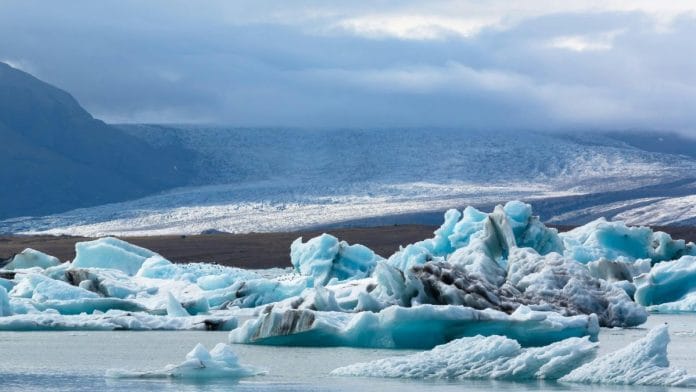Bengaluru: Virologists from the United States, who collected ice core samples from the Guliya Glacier in the Tibetan plateau, have discovered the genomes of over 1,700 ancient viruses, with the oldest dating to more than 40,000 years ago. The viruses, preserved in ice, had existed across nine distinct time periods with widely varying global climatic conditions.
The team of virologists, led by Zhi-Ping Zhong of the Ice Core Palaeontology Group at Ohio State University, analysed the virus genomes to understand their evolution and how they develop the ability to survive in harsh environmental conditions.
The findings were published last week in the journal Nature Geoscience.
They used DNA extraction and metagenomic (study of genetic material derived from environmental samples) methods to sequence these from the 310-metre-long ice core, and analysed the differences between them.
The virologists discovered that the viruses have vast genetic differences, which depend on whether they were active in cold climate periods or warm. They discovered several viral communities that were endemic to the region, without connection to outside viruses. These viral communities were active around 11,000 years ago, as the world’s climate transitioned from the last ice age (that began about 100,000 years ago and ended about 11,000 years ago) to the warm interglacial period that began about 11,000 years ago.
The authors on the paper also said previous research has found that viruses not only infect hosts, but also “steal” the hosts’ genomic sequences to enrich their own. This allows viruses to survive extreme climatic conditions.
Also read: Mars may have oceans’ worth of water underground, but this doesn’t mean it’s ready to be colonised
Ancient microbes hidden in ice
Most freshwater on the Earth is stored in the form of glacial and polar ice. The largest quantities of ice are found at the North and South Poles, and the Himalayan region—often called the Third Pole.
These regions have been under permanently icy conditions since their formation and since the last ice age, that ended about 11,000 years ago, and have well-preserved remains of past life over the ages, including microbes. Permafrost and glaciers are also known to harbour hundreds of thousands of species of bacteria and viruses which were active in the past in the region before getting frozen in ice.
As the Earth warms and large quantities of glaciers and permafrost melt, these viruses are at risk of being exposed to the environment, potentially leading to new diseases and infections that never occurred before.
Glaciologists and palaeo-biologists use ice core samples to understand past climatic conditions. As ice piles up every year in the form of fresh snow, layers and layers of ice build up, trapping environmental structures in the form of particles and microbes.
Ice cores are long, tube-like structures that are obtained by drilling into glaciers, and allow scientists to analyse palaeo-environmental conditions layer by layer over time, allowing them to peek thousands of years into the past.
The researchers sequenced viruses and performed genomic analyses on nine different samples from 310-metre cylindrical ice core. Each sample represented distinct time periods in the past, separated by thousands of years.
How virologists obtained genetic material
The team uncovered a total of 1,705 distinct species of viruses, with the oldest dating back to being active at least 41,000 years ago.
The team made several significant findings about the ancient viruses from their genomes. Firstly, viruses that were alive during cold periods were very different from those that were alive during warmer times, especially in terms of genomic sequences.
Secondly, several related viruses were found, which are distinct from existing virus genomes in databases, indicating that many viruses were local and endemic to the Tibetan plateau region. The authors termed this “regional associations” among the Guliya-preserved viruses over time.
“Biogeographic analyses show that approximately one-fourth of Guliya viral operational taxonomic units overlap with the global dataset,” the authors explained in the paper.
The authors wanted to go a step further and understand how these different viruses survived over time and metabolically adapted to large-scale, changing climatic conditions.
They noticed that every virus attacked bacteria in the samples from the Flavobacterium family, which is commonly found in glaciers. So, they analysed the genomes of the viruses and compared them to changes in bacterial genomes.
The researchers found that when the viruses infected bacteria, they stole genes from the latter, incorporating bacterial sequences into their own structure. Called auxiliary sequences, these enabled the viruses to “enrich” and change their metabolism to survive harsh environmental conditions.
Ancient viruses not only performed gene transfer, but also genetically weakened the host.
Modern viruses do this too. This phenomenon is commonly seen in marine planktons, where gene transfer between hosts and viruses occur.
In addition to this, the authors theorised from their data that during cold-to-warm changes in the region’s climate, changing winds brought in other viruses, which put selection pressure or evolutionary pressure on the existing viruses to survive in the region.
Studying these viral genomes helps in understanding how they function today, what they do after infection, and how viruses can survive future warmer conditions.
The scientists noted in their paper how their findings highlight the lack of data on the fast-disappearing ice cores from across the world, which can yield a wealth of information about the past—especially about “eukaryotic viruses and their roles in the story of the Earth system, hopefully before the Anthropocene warming compromises all the glacial ice essential to tell such stories.”
The current time we are living in is known as the Anthropocene era, and global warming is called Anthropocene warming.
(Edited by Radifah Kabir)
Also read: Fossil of extinct human species Denisovan identified in Tibetan plateau, their diet pattern revealed






